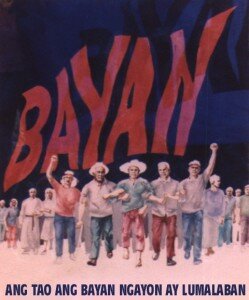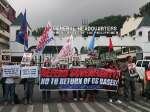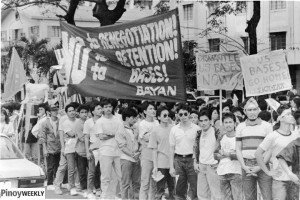
(Ang papel na ito ay tinalakay ni Nathanael S. Santiago, pangkalahatang Kalihim ng Bayan Muna at Makabayan sa pagdiriwang sa ika-20 taong anibersaryo ng matagumpay na pagpapatalsik ng mga base militar ng US sa Pilipinas na inorganisa ng BAYAN sa UP Malcol Hall)
Mayroong kasabihan noon, “mapapatalsik ang pangulo ng Pilipinas ngunit hindi ang mga base militar ng US sa bansa”. Nagmumula ito sa pagtingin na grabe ang kapangyarihan ng US. Nadidiktahan ng US ang gubyerno natin. Kontrolado ng US ang mahahalagang bahagi ng ating ekonomya. Namamayani ang kaisipang kolonyal.
Noong Setyembre 16, 1991, nangyari ang wari’y imposible. Nagapi ng makabayang kilusan ang pinagsamang pwersa ng US, gubyernong Cory Aquino, militar at malalaking negosyo. Walang nagawa ang panunuhol, presyur at pananakot. Sa lakas ng agos ng makabayang sentimyento, mga protesta at aksyong masa, itinakwil ng Senado sa botong 12-11, ang US-RP military bases agreement.
Nagtangka pa ang gubyernong US at Aquino na magmaniobra sa anyo ng panukalang referendum, 7-taong withdrawal, 3-5 taong phase out. Ayaw talaga nilang bitawan ang US bases laluna ang higanteng Clark Air Base at Subic Naval Base. Ngunit itinumba ang lahat ng ito ng higit na malakas na agos ng makabayang sentimyento matapos ang pagtatakwil ng Senado sa US bases treaty. Katapusan ng taong 1992, umalis ang huling tropang Amerikano lulan ng US warship Bettan Wood.
Ano ang saligang aral na mahahango natin sa laban sa base militar ng US? Makapangyarihan ang US. Superpower nga ang bansag sa US. Pero higit na makapangyarihan ang mamamayan. Kapag sila ay namulat at sama-samang lumaban, magagapi kahit ang kapangyarihan ng US.
Sa paggunita sa ika-20 taon ng makasaysayang araw na iyon, kinikilala natin ang makasaysayang pagtindig sa panig ng bayan ng tinawag na manificent 12 – Palakpakan natin sina Sen. Teofisto Guingona, Rene Saguisag, Victor Ziga, Sotero Laurel, Ernesto Maceda, Agapito Aquino, Orlando Mercado, Aquilino Pimentel, Juan Ponce Enrile at Joseph Estrada. Mas malakas na palakpakan kina Senador Wigberto “Ka Bobby” Tanada at Senate President Jovito Salonga.
Walang isang tao o grupo ang pwedeng umangkin sa makasaysayang tagumpay laban sa US bases. Sa ultimo ang tagumpay ay tagumpay ng mamamayan nakipaglaban para sa pambansang kasarinlan.
Kinikilala natin kung gayon ang libu-libong mamamayan na nag-ambag ng lakas, talino at panahon para mangyari ang Setyembre 16. Bigyan natin ng palakpakan mga sumusunod – ang mga gerilya at makabayan ng Gitnang Luzon na lumaban sa pagbabalik ng mga Amerikano; gayundin sina Senador Claro M. Recto, Lorenzo Tanada at Jose Diokno; sina Satur Ocampo, Renato Constantino, Ambrosio Padilla; ang pinakamatalim na kalaban ng imperyalismong US, si Jose Maria Sison, ang Communist Party of the Philippines, New People’s Army at National Democratic Front; ang mga lumahok sa Sigwa ng Unang Kwarto; ang mga nangahas lumaban at nagpabagsak sa diktadurang US-Marcos.
Palakpakan natin ang progresibong bloke ng Constitutional Commission sa pangunguna nina Atty. Senseng Suarez at Lino Brocka; sina Prof. Roland Simbulan, Capt. Danilo Vizmanos, RC Constantino at Cookie Diokno; sina Lean Alejandro, Felixberto at Rolando Olalia at Crispin Beltran; sina Sen. Nikki Coseteng, Nelia Sancho, Sr, Mary John Mananzan, Liza Maza; ang malalapad na kilusan, Nuclear Free Philippines Coalition, Anti-Bases Coalition, Anti-Baseng Kilusang Demokratiko at Anti-Treaty Movement; At syempre, ang pumagitna at nanguna sa pukpukang laban mula 1985 hanggang 1991, ang Bagong Alyansang Makabayan; at ang lahat ng kasaping organisasyon ng BAYAN.
Pinakamatunog na palakpakan sa mga martir at bayani ng kilusang makabayan.
Sa kabuuan, pinamunuan ng kilusang pambansa demokratikong ang matagumpay na laban sa base militar. Inilatag ng mga pambansang demokrata ang kumprehensibo at matalas na pagsusuri sa base militar at imperyalismong US bilang pangunahing kaaway ng sambayanan at ang ugnayan nito sa suliranin ng pyudalismo, burukrata-kapitalismo at pasismo. Naging pinakamasugid at pinakapuspusang kaaway ng base militar at imperyalismong US ang kilusang pambansa demokratiko.
Ang tagumpay laban sa base militar ay hindi nakuha overnight. Hindi ito produkto ng ilang buwang kampanya. Ang tagumpay ay kumulatibong produkto ng kalahating siglong tuluy-tuloy na pagmumulat, pagbubuo ng pagkakaisa at pakikibaka laban sa base militar ng mga pambansang demokrata at mga alyado nito.
Ang tagumpay ay kumulatibong epekto ng apat na salik.
- Masikhay at makabayang pagmumulat sa mamamayan
- Pakikibaka at pagpapabagsak sa diktadurang US-Marcos
- Pagbubuo at pagkilos na malawak na hanay na anti-bases, anti-nukes at anti-treaty
- Sustinidong kampanya, mga militante at malalaking aksyong masa laban sa base militar
Masikhay na pagmumulat sa mamamayan
Susi sa tagumpay ng paglaban sa US bases ang pagmumulat sa mamamayan. Hindi madali ang pagmumulat dahil kontrolado ng US at maka-US ang sistema ng edukasyon, mas midya at malalaking grupong relihiyoso. Sa pasimula, pabor sa pananatili ng US bases ang malaking mayorya ng mamamayan, iilan pa lang ang mulat at tutol dito.
Mula tuwirang kolonyal na paghahari noong 1899, itinatag ng US ang malakolonyal na paghahari sa bansa pagpasok ng taong 1946. Tiniyak ng US ang patuloy na kontrol sa ating ekonomya sa pamamagitan ng Bell Trade Act na naglalaman ng Parity Rights. Pinagtibay ito ng Kongreso noong Hulyo 2, 1946.
Noong Marso 4, 1947 nilagdaan ang US-RP Military Bases Agreement para sa US bases at facilities sa 23 lugar sa loob ng 99 taon. Binigyan ng extraterritoriality ang US sa naturang mga base, ibig, sabihin teritoryo at nakapailalim soberenya at batas ng US ang mga ito. Pinakamalaki at pinakaestratehikong ang Clark Air Base sa Pampanga at Subic Naval Base sa Zambales. Noong Agosto 30, 1951 pinirmahan ang Mutual Defense Treaty.
Kinailangang bakbakin ng mga progresibo ang mga kasinungalingan ng US at mga propagandista nito. Kailangang ipakita hindi lang higit ang pinsala sa soberenya, seguridad, kapayapaan, kababaihan at mga bata at kalikasan kaysa sa pakinabang sa pananatli ng US bases; kahit ang pakinabang ay palamuti o panloloko lamang. Ano ang mga tampok na kasinungalingan?
- Magkapareho daw ang interes ng US at Pilipinas at pareho ang ating kalaban. Ang problema maraming inaapi at nagiging kalabang bansa ng US. Ang Pilipinas, wala!
- Sasakupin daw tayo ng Unyong Sobyet. Deterrent daw ang US bases sa pananalakay militar at nukleyar ng ibang bansa. Sa kabaliktaran, magnet sa atake ng mga kalaban ng US. Hindi ba’t unang inatake ng Japan ang US bases?
- Bagbagsak daw ang ekonomya ng Gitnang Luzon at Pilipinas kung aalisin ang US bases. May 20 taon ng napaalis ang base militar, nangyari ba ito?
- Kailangan daw ang US bases para sa modernization ng AFP. Ilang dekada na ang US bases, namodernisa ba ang AFP? Mas importanteng punto, modernisasyon laban kanino – laban sa mga Pilipinong nakikibaka para sa kasarinlan at demokrasya?
Napakarami pang propaganda at kasinungalingan ang binakbak natin noon.
Nailantad natin ang totoo. Ang base militar ay kasangkapan ng US para protektahan ang kanyang pang-ekonomyang interes at pampulitikang dominasyon sa Pilipinas at daigdig at bilang lunsaran ng panghihimasok ng US sa Pilipinas, Tsina at iba pang bansa. Kailangan ng US ang base militar gaya ng kailangan ng magnanakaw ng baril na itututok sa kanyang biktima.
Dapat ipaglaban ng mamamayan ang pambansang kasarinlan at demokrasya kung nais nitong lumaya sa dayuhang mananakop. Kailangang makintal ang makabayang kamalayan at diwang palaban upang mapag-isa at mapakilos ang mamamayan.
Mamayagpag ang kaisipang kolonyal kung hindi babakbakin ang kasinungalingan at hindi ilalantad ang malakolonyal na relasyon ng US at Pilipinas at ang salot na hatid ng US bases. Dapat ding ipakita na kayang tumindig at umunlad ng bansa kahit wala na ang US bases. Higit pa, kailangan mulatin ang malaking mayorya ng mamamayan sa mapagsamantala at mapang-aping katangian ng imperyalismo at sa pangangailangang wakasan ang dominasyon ng imperyalismong US sa bansa.
Maitatala sa kasaysayan na nag-ambag sa makabayang pagmumulat ang mga akda ni Jose Maria Sison laluna ang Struggle for National Democracy at Philippine Society and Revolution, ang mga talumpati at sulatin nina Senador Recto, Tanada. Diokno, Constantino, ang Bases of our Insecurity ni Prof. Roland Simbulan, ang mga pulyeto, praymer, lathalain ng iba’t-ibang lihim at hayag na organisasyon, mga makabayang tula, pinta, awit, sayaw, stageplay, pelikula at iba pang likhang sining.
Nagbunga ang di mabilang na mga pagbabasa at pag-aaral, mga discussion groups, room-to-room, house-to-house, forum, symposium, pulong bayan, misang bayan, teatrong bayan, konsyerto, mga kulturang pagtatanghal. Kung walang pagmumulat sa pagiging makabayan, mamayagpag ang kaisipang kolonyal sa panahon ng makasaysayang araw ng Setyembre 16.
Lumaki at lumakas ang pwersa ng pagtutol at paglaban bunga ng mga inilantad na isyu laban sa base militar at ng pagkamulat ng mamamayan.
Sa katunayan, maraming rebisyon ang isinagawa sa US-RP MBA para pahupain ang mga pagtutol at protesta laban sa US at base militar nito.
Talaan ng rebisyon ng US-RP MBA sa gitna ng lumalakas na pagtutol ng mamamayan:
| Dec. 5,1956 |
Naobliga ang US na pormal na kilalanin ang soberenya ng Pilipinas sa 23 base at instalasyong militar sa naganap na Garcia-Bendetsen conference |
| Oct. 28, 1959 |
Ginawa ang turn-over ng Olongapo bilang bahagi ng teritoryo ng Pilipinas. |
| Aug. 10, 1965 |
Pumayag ang US na irenounce exclusive jurisdiction nito sa mga krimen sa loob ng US bases at nagbuo ng joint criminal jurisdiction committee. |
| Sept. 16, 1966 |
Pinaiksi ng Ramos-Rusk agreement sa 25 taon termino ng bases treaty. |
| 1979 |
Pormal na ipinailalim sa Filipino base commander ang Clark at Subic. Itinirik ang bandila ng Pilipinas. Rebyu tuwing 5 taon. |
| 1983 |
Nabuo ang kasunduan na magbibigay ng $900 M best effort security assistance ang US sa Pilipinas |
| 1988 |
Itinaas sa $482M kada taon hanggang 1991 ang security assistance sa ilalim ng Manglapus-Shultz Agreement. |
Gayunman, pinanatili sa saligan ang walang patumanggang paggamit ng pwersang militar ng US sa mga base at instalasyon sa bansa. Dahil sa matalas na paglalantad at pagmumulat, nawalang bisa ang panlilinlang ng mga renegosasyon at rebisyon. Lalo pang dumami ang namulat at tumutol.
Pakikibaka at tagumpay laban sa diktadurang US-Marcos
Mahalagang salik ng tagumpay ang magiting at matagumpay na pakikibaka ng mamamayan laban sa pasistang diktadurang US-Marcos. Inugnay ng mga progresibo ang pakikibaka laban sa diktadurang Marcos at pagsuporta ng US sa diktadura para panatiliin ang mga base militar nito.
Mulat at mahusay na naikawing ng kilusang pambansa demokratiko kapwa ang pakikibaka at pagbubuo ng nagkakaisang hanay laban sa pasismo sa pakikibaka laban sa imperyalismong US at sa pyudalismo bilang panlipunang base ng imperyalismo.
Ipinataw ni Marcos ang batas militar para ibayong magkamal ng yaman at kapangyarihan para sa sarili, mga kroni at imperyalismong US. Todong inayudahan ng US ang diktadurang Marcos para mapanatili ang base militar at pang-ekonomyang kontrol sa Pilipinas.
Hindi lang masa at panggitnanng pwersa, marami-raming elemento ng naghaharing uri na anti-Marcos ang nagbukas ng isip o nakumbinsi na hindi lang diktadurang Marcos ang dapat patalsikin kundi pati ang US bases. Gayunman, mas maraming elemento pa rin ng naghaharing uri ang naghahabol na kunin ang suporta ng US para sila ang ihalili kay Marcos, kapalit ang pananatili ng mga base mlitar ng US.
Sa katunayan, si Cory Aquino ay pumirma noong 1984 sa kasunduan ng isang Convenors’ Group na ang isang panawagan ay paalisin ang mga base militar matapos ang Setyembre 1991. Ngunit binawi niya ito matapos magmaniobra ang US na gawin siyang manok panabong kay Marcos.
Nang mapatalsik ang diktadurang Marcos, nangampanya ang Bayan, Partido ng Bayan at Campaign for Sovereign Philippines na ipasok sa Saligang Batas ang prubisyon na hindi na ieextend ang bases treaty at aalisin na ang US bases sa taong 1991.
Sa dikta ng gubyernong US at Aquino, tinanggihan ng mayorya ng Constitutional Commission ang naturang panukala. Sa halip, inilagay sa Konstitusyon, Seksyon 24, Arikulo 18, ang prubisyong nagbubukas sa ekstensyon ng mga base militar pagkatapos ng 1991.
Gayunman, nagamit natin kinalaunan ang sekundaryong aspeto ng prubisyon, ang tuwirang pagbabawal sa armas nukleyar at ang pag-aalis sa mga base militar maliban magkaroon ng panibagong tratado na pagtitibayin ng Senado.
Pagbubuo ng mga alyansa laban sa base militar
Importanteng salik din sa tagumpay ang pagbubuo at pagkilos ng iba’t-ibang tipo at anyo ng alyansa laban sa base militar at imperyalismong US. Sa mga alyansa, pormal at di pormal, nagtutulungan ang mga manggagawa, magsasaka, petiburgesyang lunsod, pambansang burgesya at hindi iilang elemento ng naghaharing uri na kontra-nukleyar o kontra sa base militar.
Hayaan niyong pasadahan ko ang ilang tampok na alyansang may pambansang katangian.
Taong 1946 nakapagpanalo ng anim na kongresista ang Democratic Alliance na binubuo ng lumang Partido Komunista ng Pilipinas at Nacionalista Party ni Sergio Osmena. Ngunit diniskwalipika at hinarangan ang pag-upo ng anim sa Kongreso para maipapasa ng gubyernong US at Roxas ang Bell Trade Act at Parity Rights.
Mula 1949, nanguna si Sen. Claro M. Recto, kumatawan sa mithiin ng pambansang burgesya, sa pag-atake sa US-RP MBA, Mutual Defense Treaty at Parity Rights. Naging katuwang niya si Sen. Lorenzo Tanada sa pagbubuo ng Nationalist Citizen’s Party na sumabak at natalo sa halalang panguluhan noong 1957.
Itinatag noong Pebrero 8, 1967 ang Movement for the Advancement of Nationalism na nanguna sa malawak na hanay laban sa base militar at imperyalismong US. Pinamunuan ang MAN ni Sen. Tanada bilang tagapangulo at ni Prof. Sison bilang pangkalahatang kalihim.
Disyembre 26, 1968 at Marso 21, 1969, muling itinatag ang PKP at ang Bagong Hukbong Bayan. Noong Abril 24, 1973, pinasinayaan ang National Democratic Front. Isinulong ng CPP-NPA-NDF ang armadong rebolusyon laban sa imperyalismong US at papet na estado nito.
Noong 26, 1981, pinanguluhan ni Sen. Tanada ang pagtatatag Nuclear Free Philippines Coalition. Noong 1984, naganap ang kauna-unahang matagumpay na welgang bayan sa Bataan bilang protesta sa pagtatayo ng Bataan Nulear Power Plant sa prubinsya. Iniugnay ang protesta sa paglaban sa US bases.
Noong 1983, pinamunuan ni Sen. Jose Diokno at kasunod ng anak niyang si Cookie ang Anti-Bases Coalition. Sinamahan ito nina Sen. Tanada, JBL Reyes, Salvador Lopez at mga progresibo.
Matapos patayin si Sen. Ninoy Aquino noong Agosto 21, 1983, nagkaroon ng daluyong ang malalaking kilos-protesta. Naglitawan ang iba’t-ibang organisasyon ng batayang masa, panggitnang pwersa at reaksyunaryong anti-Marcos. Nagkaroon ng iba’t-ibang inisyatiba para buuin ang iba’t-ibang alyansa laban sa diktadurang Marcos at laban sa suporta ng US sa diktadura.
Naging aktibo ang mga progresibo sa pagbubuo at pagpapalakas ng Lakas ng Bayan. Nagsanib ang Pwersa ng Demokratikong Pilipino at Laban. Naglabas ang PDP-Laban ng pusisyon pabor sa pagpapaalis ng US bases.
Taong 1984 nang tipunin ang Convenors Group nina Tanada, Jaime Ongpin at Cory Aquino upang magbalakangkas ng programa ng pagkilos at alternatibo laban sa diktadurang Marcos. Bahagi ng programa na pinagkaisahan ang pag-aalis ng US bases. Nireject ni Doy Laurel, isa sa nangungunang presidentiable, ang Convenors Group dahil sa pusisyong anti-bases. Umatras si Aquino sa pusisyong anti-bases nang kausapin ito ng US at magdeklara ng pagtakbo noong Dec. 1985 sa snap presidential election laban kay Marcos.
Binuo noong 1984 ng mga pambansang demokrata kasama ng mga demokratikong liberal ang National Alliance for Justice Freedom.
Noong Mayo 5, 1985, itinatag ang ngayo’s pinakamalakas at militanteng alyansa sa bansa, ang Bagong Alyansang Makabayan.
Binuo ng BAYAN, iba pang blokeng pulitikal at ni Sen Tanada at RC Constantino. noong 1988 ang Anti-Baseng Kilusang Demokratiko. Pinayungan nito ang paglaban sa panahon ng review ng US-RP Military Bases Agreement. Noong 1989, nagdeklara si Sen. Joseph Estrada na sasamahan niya sina Sen. Salonga at Tanada sa paglaban sa US bases. Nasurpresa ang di iilan, sa pagtindig ni Sen. Enrile laban sa panibagong US bases treaty.
Noong 1991 nabuo ang pinakamalawak na alyansa, anti-treaty movement, sa panahon na nagaganap ang negosasyon ng guybernong US at Pilipinas para sa panibagong US bases treaty. Tuwiran o di man tuwiran, naging bahagi ng anti-treaty movement ang lahat ng mga uri at sector na kritikal at kontra sa panibagong US bases treaty, pabor man sila o hindi sa base militar.
Noong Setyembre 12, nagdeklara ng national ceasefire ang NDF upang suportahan ang mga senador sa magiging pasya nila laban sa panibagong bases treaty.
Sustinidong kampanya, militante at malalaking aksyong masa sa huling 5 taon.
Mapagpasyang salik ang mga aksyong protesta sa tagumpay dahil ito ang nagtatampok ng pagtutol ng malawak na bilang ng mamamayan. Ginapi nito ang anumang tangka ng gubyernong US at Arroyo na palabasing sang-ayon ang mamamayan sa pananatili ng US bases. Nagsilbing pangumbinsi at presyur ito upang magpasya ang Senado laban sa panibagong tratado sa US bases.
Pinangunahan ng BAYAN, mga kasaping organisasyon at mga alyado nito ang sustindong kampanya, mga militante at malalaking aksyong protesta laban sa US bases. Mula 1985 hanggang 1991, nagpursigi na ang Bayan sa malaganap na edukasyong pampulitika, propaganda, pakikipag-alyansa at mga militanteng aksyon laban sa US bases.
Bukod sa makasaysayang mga petsa, Enero 30, Marso 16, Hunyo 12, Hulyo 4, Nobyembre 30, sinasalubong at sinusundan ng protesta ang mga upisyal ng US at barkong bumibisita sa Pilipinas. Pinakatampok ang mga sakbayan at lakbayan na pinangunahan ng UP, ng LFS at ng BAYAN.
Ang LFS halos linggu-linggo may aksyon sa US embassy. May panahon na araw-araw may protesta bago ang mga importanteng petsa o kapag may bumibisitang upisyal at barkong pandigma ang US. Inspirado ng militansya ng FQS, hindi pumapayag at nag-aalma ang mga kabataa’t istudyante kapag humarang ang pulisya. Hindi alintana ang palo ng truncheon at teargas, gumigitgit ang mga kabataan hanggang makaalpas sa hanay ng pulis at makarating sa gate ng US embassy. Puntirya palagi ang zeal ng US embassy. Lahat na ginawa doon, binato ng bugok na itlog, ng pinturang pula. Nilagyan ng X. Nilagyan ng notice of eviction. Pinukpok ng martilyo, kaya lang di nabasag. Kaya sumunod na linggo, minaso, ayun nabasag. Hindi mabilang ang sinunog ng mga aktibista na American flag.
Tumindi ang mga protesta sa US embassy at Malakanyang sa panahon ng review ng US bases noong 1988. Sinindihan nito ang malawak na debate sa midya at kahit saan, kung pananatiliin o paalisin ang US bases.
Mainam sa puntong ito na bigyang tuon natin sa pagtalakay ang taong 1991.
Nangingibabaw pa rin ang impluwensya ng US, alam nating hindi magiging madali ang laban para sa pagpapatalsik sa mga US bases sa pagpasok taong 1991.
- Mayorya ng mamamayan ay pabor pa rin sa US bases, ayon sa survey, kahit pa pababa ang bilang ng mga pro-bases.
- Tahasang maka-US si Pres. Aquino, ang AFP, PNP at matataas na upisyal at determinado sila na itulak ang pagpapanatili ng US bases.
- May pagbasa tayo na pabor o malamang pumabor sa extensyon ng base militar ang malaking mayorya ng mga senador, mahirap makakuha ng 8 senador noon.
- Hindi madaling makapagmobilisa ng malaking bilang laban sa base militar kahit pa maiingay ang mga militante. Abala ang mga tao sa pang-araw-araw na usapin ng kahirapan.
Plinano ng BAYAN na pagtuunan ang taktikal na laban sa ikalawang hati ng taon para ipresyur ang Senado na itakwil ang panibagong tratado sa US bases. Pero nagpaplano rin tayo ng kagyat at malakihang welgang bayan sakaling pagtibayin ng Senado ang US bases.
Sa pagtakbo ng mga araw at ng labanan laluna nang maganap ang negosasyon, lumaki ng lumaki ang pusiblidad ng tagumpay dahil sa mga paborableng kalagayan at pagpupunyagi ng mga pwersang anti-bases at anti-treaty.
- Batbat ng krisis, nasa resesyon ang ekonomya ng US noong 1991. Tinalo ni Bill Clinton si Bush sa linyang “it’s the economy stupid” kahit pa namayagpag si George Bush, Sr. sa gera laban sa Iraq. Dahil sa krisis walang maibigay na malaking military economic aid ang US sa Pilipinas bilang suhol sa 10 taong extension ng US bases. Isa pa, nakita sa Iraq war ang moderno at mabilisang paraan ng deployment ng militar.
- Gumuho na ang Unyong Sobyet, inihudyat ng pagguho ng Berlin Wall noong 1989. Nagpapahina ito sa argumento laban sa inimbentong banta ng pananakop ng Unyong Sobyet.
- Malaganap na ang diskuntento sa rehimeng Aquino dahil sa patuloy na kahirapan, korupsyon at mga paglabag sa karapatang pantao. Naglalaho na noon ang Cory magic na anumang bagay na basbasan ni Cory, susuportahan ng mayorya ng mga Pilipino. Sa katunayan, higit 80,000 ang namobilisa ng BAYAN at ng iba pang bloke sa martsa rali mula Liwasang Bonifacio noong Pebrero 26 pangunahin dahil sa isyu ng kahirapan. May nasisilip tayong momentum ng kilusang masa laban sa kahirapan at laban sa rehimeng Aquino.
- Sobrang pambabraso at pambabarat ang ginawa ng Armitage panel sa negosasyon. Pumosturang matigas sina Manglapuz para humingi ng upa – $825 milyon bawat taon. Pero brinaso sila ni Armitage at pinapayag sa $203 M annual military aid, hindi upa, best effort pa. Mas mababa pa ito sa naunang taunang $481M aid. Sumaling sa national pride ang pambabraso at iba pang pang-iinsulto nila Armitage. Hindi iilan ang pro-US bases ang nadisguto sa naging takbo at kinalabasan ng negosasyon.
Sa panahon ng negosasyon, sumikad ang kampanyang anti-US bases at anti-treaty. Isinagawa ng iba’t-ibang organisasyon ng BAYAN, ng ABAKADA, anti-treaty movement, mga kabataa’t istudyante, guro, kababaihan, mga manggagawa, magsasaka, taong simbahan at iba pang prupesyunal ang sunud-sunod at araw-araw na mga pagmuumlat, aksyong protesta, pamemresyur at lobbying sa Senado.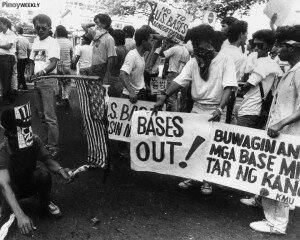
Naging higit na mainit, matalas at malaganap ang debateng pampubliko sa mas midya, mga radio, TV talkshow, mga forum at kahit saang talakayan at kwentuhan.
Kung hindi ako nagkakamali ng alala, ayon sa SWS survey, ilang araw bago ang Setyembre 16, halos hati ang mamamayan sa pagitan ng pabor at kontra sa US bases.
Nanawagan ng “people power rally” si Presidente Cory Aquino pabor sa US bases. Ginamit ang poder at rekurso ng estado para sa rali sa Agosto 10, pero wala pang 100,000 ang namobilisa ni Cory sa Luneta. Nalantad na hinakot at tinakot pa ang mga dumalo, karamihan ay mga empleyado ng gubyerno. Mabilis nalusaw ang rali nang bumuhos ang ulan.
Kahit kulang isang linggo ang nalalabi para maghanda, nagpasya ang BAYAN at ABAKADA na tapatan ang rali ni Aquino noong Agosto 10. Pasilip sa pag-agos ng sentimyentong makabayan at national pride, higit 45,000 ang namobilisa ng kilusang anti-base sa Liwasang Bonifacio. Nanatili ang bulto ng mga tao kahit umulan, mainit na naninindigan laban sa US bases.
Sa makasaysayang araw ng Setyembred 16, humugos ang higit 80,000 mga tao, mayorya ay mula sa BAYAN, patungong Senado, nananawagang itakwil ang US bases treaty. Nagmartsa, nagsaya at nagsayaw tayo sa panalo ng sambayanan laban sa panibagong tratado sa US bases. Sa botong 12 laban 11 senador, nanalo ang resolusyon laban sa panbiagong tratado sa base militar.
Bilang pagsusuma, narito ang mga aral sa matagumpay na laban sa US bases.
- Makapangyarihan ang imperyalismong US at papet na gubyerno nito. Pero higit na makapangyarihan ang soberanong mamamayan. Kapag sila ay namulat at sama-samang lumaban, magagapi nila kahit ang kapangyarihan ng US at ng reaksyunaryong papet nito.
- Susi ang pagmumulat sa mamamayan upang mapakilos sila para ipaglaban nila mismo ang kanilang pambansa at demokratikong interes. Kailangang bakbakin ang mga kasinungalingan, maging mapanuri kaninong interes nagsisilbi ang isang patakaran o kaasyusan at pukawin ang mamamayan na gamitin ang kapangyarihan ng sama-samang pagkilos.
- Kailangan ang mulat at mahusay na pag-uugnay ang mga isyu laban sa pasismo o burukrata-kapitalismo, imperyalismo at pyudalismo. Mahusay na naiugnay ng mga progresibo ang isyu ng US bases sa mapagsamantala at marahas na katangian ng imperyalismo at sa pag-ayuda sa diktadurang Marcos mapanatili lamang ang US bases at kontrol sa ekonomya.
- Mahalagang salik sa anumang tagumpay ang pagbubuo ng malawak na hanay laban sa US bases o anupamang napapanahong isyu at laban para sa interes ng mamamayan. Kailangang palakasin ang pwersa at alyansa ng uring mangagawa at magsasaka, kabigin ang suporta at paglahok ng panggitnang pwersa, kunin ang pinakamaraming pusibleng alyado sa hanay ng mga naghaharing uri upang gapiin ang punong papet ng imperyalismong US.
- Mapagpasya ang iba’t-ibang anyo ng protesta laluna ang malalaking militanteng aksyon dahil ito ang nagtatampok ng pagtutol ng malawak na bilang ng mamamayan. Ginapi nito ang anumang tangka ng gubyernong US at Arroyo na palabasing sang-ayon ang mamamayan sa pananatili ng US bases. Nagsilbing pangumbinsi at presyur ito upang magpasya ang Senado laban sa panibagong tratado sa US bases.
Maraming salamat po at mabuhay ang sambayanang Pilipino! #

 By Prof. Jose Maria Sison
By Prof. Jose Maria Sison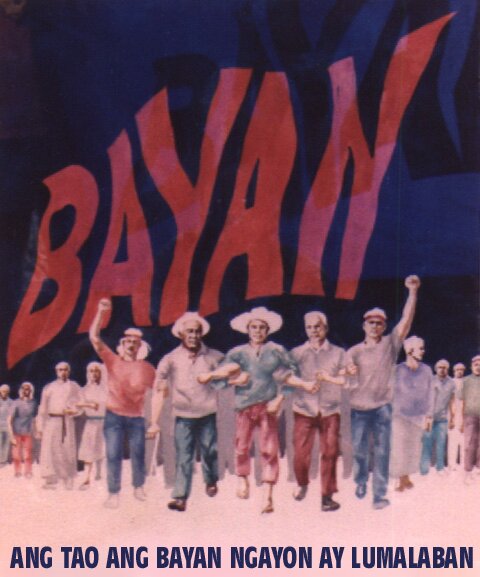

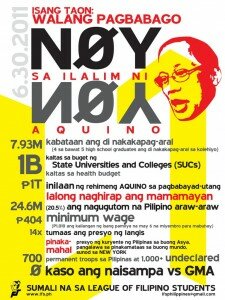 by Renato Reyes, Jr.
by Renato Reyes, Jr.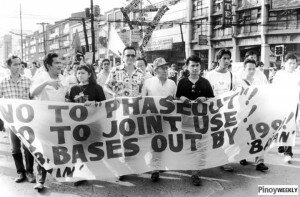
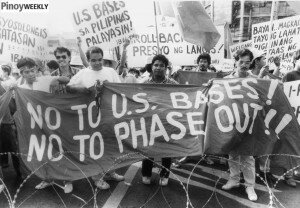 When I am asked here or abroad what are the two outstanding achievements of the Philippine mass movement in the 20th century, without thinking twice I declare it is the ouster of the dictator Marcos through a people’s uprising in 1986 and the booting out of US military bases through the Philippine Senate rejection of a new treaty in 1991.
When I am asked here or abroad what are the two outstanding achievements of the Philippine mass movement in the 20th century, without thinking twice I declare it is the ouster of the dictator Marcos through a people’s uprising in 1986 and the booting out of US military bases through the Philippine Senate rejection of a new treaty in 1991.

